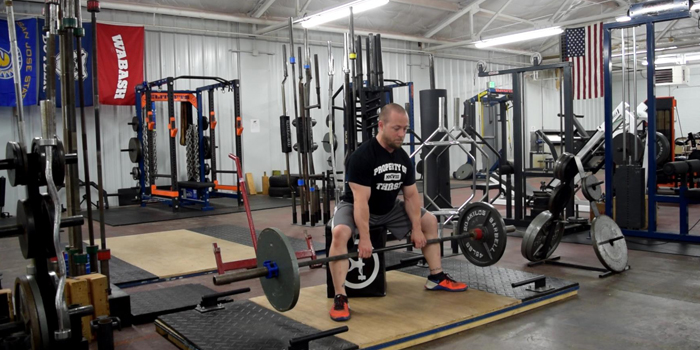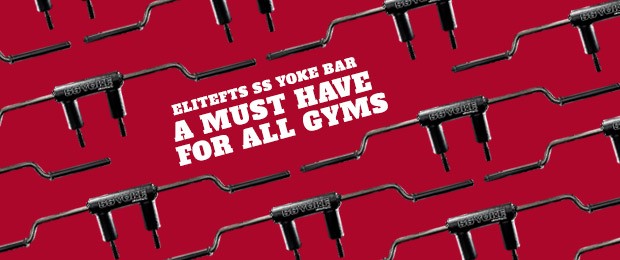
Dig up any great training deadlift article here on elitefts, and you’ll find the two main parts to a huge pull are the glutes, hamstrings, and the back. All the greatest deadlifters have a massive, huge back stacked with huge glutes and hangin’ hammies. For this article, I’m going to discuss five exercises that I’ve had success with building a back that is not only huge but will aid your pull come meet day.
A few things we need to determine though is what is actually important when it comes to back strength for the deadlift. When properly deadlifting, we know that the back is not a prime mover, it acts isometrically to help maintain position throughout the entire pull. This doesn’t mean we can’t train extension of the back (with things like the Reverse Hyper™, back extensions, and the like), but that in more cases than not, we need to train it isometrically for it to have carryover for the deadlift come competition day.
RELATED: Building the Raw Deadlift
This involves the erectors to maintain position (neutral spine, or very close to it with some conventional deadlifters), the lats, and the rhomboids/traps to maintain scapula position (depressed and hunkered down). Knowing this, we can begin to formulate a list of priorities, but more importantly, call upon five exercises I’ve seen help improve back strength for the deadlift.
Snatch Grip Deadlift Off Blocks or Mats
While I hate the snatch grip deadlift, it’s a great exercise to build the deadlift with a bit of variety. The wide grip taxes the lats to a higher degree and will force the lifter to maintain a neutral spine more. Getting rounded on a snatch grip deadlift feels like death, so the exercise itself forces you into optimal position.
Performing the snatch grip deadlift off blocks or mats, however, is great that it takes out some of the initial leg drive and can get you more into a position to mimic a conventional deadlift. The traditional snatch grip deadlift is actually going to increase time under tension (which isn’t a bad thing!), but we will need more quad strength and leg drive to get the weight from the ground to lockout (again not a bad thing). However, if back development and strength is what you need for your pull, I suggest pulling off blocks or mats that get the bar about knee level or slightly below.
These would be best suited to be a supplemental exercise for 2-4 sets of 3-6 reps after your main deadlift work. Add bands or chains for extra suck if you wish.
SSB Good Morning
Number two on the list is the Safety Squat Bar good morning, and for a good reason. Anyone that’s read Louie’s material or enough of Dave knows that the good morning is a great exercise to aid the deadlift. Using the Safety Squat Bar is not only more comfortable to set up, but the camber of the bar is trying to bend you over and make you eat the floor.
The main thing I see botched with this is people going too heavy and letting the bar actually fold their thoracic/mid back over. To have this help aid our deadlift, we need to keep this as rigid as possible during the execution. This will help you build thick, dense, statically stronger erectors from head to butt at a mechanically disadvantageous exercise. Ensure that you’re hinging at the hips, keeping the knees soft, and maintaining that position as well. Too often you see many good mornings become a squat morning. Don’t be that person.
This is another fantastic supplemental exercise for 3-4 sets of 6-10 reps after your main deadlift work, or even after squats. If you want to upgrade the suck on these, have some elitefts bands pulling from the front of your rack or monolift.
Pendlay Row
Next up, is the classic Pendlay Row. While most deadlift articles will push the bent-over row (again, a fantastic exercise), I prefer the Pendlay Row for a couple of reasons:
- We’re constantly bent over in a neutral position aiding in isometric back strength.
- Each repetition involves a dead stop, which will require the abdominal and upper back work to have to rebrace for each rep.
- Cheating on reps becomes more challenging. You must maintain the same torso angle the whole time.
- You don’t have to actually deadlift the bar off the ground.
Think of yourself performing a Romanian Deadlift (RDL), and getting the bar to the ground. This is your start position. Perform an explosive row while maintaining good, neutral positioning, and then return the bar back to the ground. We obviously get some rowing volume in, which is never a bad thing either for the competitive powerlifter.
I prefer programming these for 3-4 sets of 8-10 reps per set. If you have access to a cambered bench bar, these are even better due to the added range of motion of the row.
Chair Deadlift
Anyone that’s performed the chair deadlift knows how bad these suck. While they are probably programmed to mainly aid in hip development (especially for sumo pullers), they also are great at building the back for the deadlift. To set this up, you’ll need a chair or plyobox that can allow your hips to get slightly lower than your starting position. Your feet will be positioned wide (sumo stance) with toes turned out and shins perpendicular to the floor. Grab the bar, and use your erectors and hips to lift the bar from the floor with a good second hold below the knee. Then return the bar to the ground and repeat. Typically I like to program these in rep ranges divisible by three, and have the lifter stand on the third rep of each (so a set of 12, the lifter would stand on reps 3, 6, 9 and 12).
This will build the low mid back up through static strength, as if you are not able to maintain position, the bar will not leave the ground. This exercise works great if you lose position as you get ready to pass the knee during a max effort lift. It will also teach you how to drive your hips forward to meet the bar rather than extending through your low back at the top of the deadlift.
As I mentioned, I like programming these with sets of 12 or 15 due to programming an option to stand up, but you don’t essentially have to do this. If you want to upgrade it, pull against bands to make those extra two-second holds suck a little more.
Straight Arm Lat Pulldowns With Iso Hold
This exercise is kind of out there, but I do feel that it’s highly overlooked when it comes to lat development for deadlifters. Most will push lat pulldowns and pull-ups (again, great exercises) but using a straight arm option with an isometric hold (preferably 2-3 seconds), can help teach the lifter how to maintain the bar in close to the body while increasing time under tension. It’s one thing to be able to sling some weight around on lat pulldowns, but how much time do you really spend in the contracted state isometrically when you do that? Maybe 2-3 seconds tops over the course of a set of 12-15 reps...because we chase the pump. Instead, hold the contracted position for 2-3 seconds to build up the strength in that range of motion to help keep your pulls in close, but also cranking up the intensity of your accessory work when you need it.
Since this is an accessory exercise, place it where it fits best for you after your main work. Typically 3-5 sets of 10-15 reps with a 2-second isometric will blow you up.
Finish Strong
I hope you found a new, different, or improved way to make your deadlift training more efficient to aid your back development to pull a new PR. If nothing else, you’ll look a little more yoked and have some different ways to train your deadlift during a plateaued period of training.











1 Comment